Papers by Permata Putri Karina
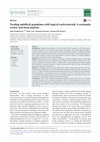
Journal of research in clinical medicine, Aug 5, 2021
Introduction: Umbilical granuloma so far can be treated with surgery or with silver nitrate. In l... more Introduction: Umbilical granuloma so far can be treated with surgery or with silver nitrate. In limited facilities, such as remote areas where the surgeons are limited, pharmacological therapy with silver nitrate or topical steroid can be administered. However, treatment with silver nitrate requires medical personnel and has unfavorable adverse effects if performed improperly. This review pointed to evaluate the effectiveness of topical steroids for treating umbilical granulomas, compared to silver nitrate therapy. Method: The literature search was done in databases including PubMed, Embase, and Google Scholar. Literature selection was performed with limitations from 2000 to 2020 to ensure the novelty and limited to articles written in English with a target population of infants younger than 6 months. To retrieve the articles, topical corticosteroids, topical steroids, and umbilical granuloma were used as keywords. Results: The findings from the included studies show similar sample characteristics. The study conducted by Brodsgaard et al. had an older mean sample age than the study of Ogawa et al. (53.4 vs. 31 days). The risk of topical steroid treatment failure on an individual study conducted by Brodsgaard et al. and Ogawa et al. was 3.0 (95%CI: 0.33-27.23) and 0.94 (95%CI: 0.40-2.21), respectively. Overall analysis, the risk of treatment failure was 1.09 (95%CI: 0.49-2.43), and there was no difference between the two interventions. Conclusions: One of the umbilical granuloma treatment options that can be considered is topical steroids, such as clobetasol propionate 0.05% or betamethasone valerate 0.12%. Although topical steroids have a longer therapeutic healing time than silver nitrate, they benefit from a better safety profile. The non-inferiority study of topical steroids to silver nitrate has not been met yet.
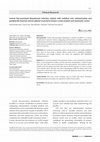
Medical Journal of Indonesia, Dec 28, 2023
BACKGROUND Central line-associated bloodstream infection (CLABSI) is a serious complication in pr... more BACKGROUND Central line-associated bloodstream infection (CLABSI) is a serious complication in preterm infants undergoing catheterization, including umbilical vein catheterization (UVC) and peripherally inserted central catheter (PICC) placement. This study aimed to compare the occurrence rate of CLABSI in preterm infants associated with UVC and PICC. METHODS We conducted a systematic review and meta-analysis of studies published from 2000 to 2023 using a random effects model from 3 databases (PubMed, ScienceDirect, and Google Scholar). This study was registered with PROSPERO (CRD42023416471). RESULTS Of 10 articles included in the systematic review, 2 were randomized controlled trials, 3 were prospective studies, and the rest were retrospective. A total of 3,962 UVCs and 2,922 PICCs were incorporated in the meta-analysis. The incidence rate of CLABSI in the UVC group was lower than that in the PICC group (1.23 versus 3.03 per 1,000 catheter days). However, the odds of developing CLABSI for infants with a UVC compared to those with a PICC were not statistically significant (odds ratio: 0.88, 95% confidence interval: 0.54-1.42). CONCLUSIONS UVCs had a lower incidence rate of CLABSI than PICCs. Therefore, additional prospective studies are required to confirm these results.
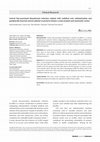
Medical Journal of Indonesia, Dec 28, 2023
BACKGROUND Central line-associated bloodstream infection (CLABSI) is a serious complication in pr... more BACKGROUND Central line-associated bloodstream infection (CLABSI) is a serious complication in preterm infants undergoing catheterization, including umbilical vein catheterization (UVC) and peripherally inserted central catheter (PICC) placement. This study aimed to compare the occurrence rate of CLABSI in preterm infants associated with UVC and PICC. METHODS We conducted a systematic review and meta-analysis of studies published from 2000 to 2023 using a random effects model from 3 databases (PubMed, ScienceDirect, and Google Scholar). This study was registered with PROSPERO (CRD42023416471). RESULTS Of 10 articles included in the systematic review, 2 were randomized controlled trials, 3 were prospective studies, and the rest were retrospective. A total of 3,962 UVCs and 2,922 PICCs were incorporated in the meta-analysis. The incidence rate of CLABSI in the UVC group was lower than that in the PICC group (1.23 versus 3.03 per 1,000 catheter days). However, the odds of developing CLABSI for infants with a UVC compared to those with a PICC were not statistically significant (odds ratio: 0.88, 95% confidence interval: 0.54-1.42). CONCLUSIONS UVCs had a lower incidence rate of CLABSI than PICCs. Therefore, additional prospective studies are required to confirm these results.
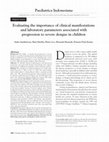
Paediatrica Indonesiana
Background The ability to predict the progression to severe dengue is crucial in managing patient... more Background The ability to predict the progression to severe dengue is crucial in managing patients with dengue fever. Severe dengue is defined by one or more of the following signs: severe plasma leakage, severe bleeding, or severe organ involvement as it can be a life-threatening condition if left untreated. Objective To identify clinical manifestations and laboratory parameters associated with dengue hemorrhagic fever disease progression in children by systematic review and meta-analysis. Methods We searched six medical databases for studies published from Jan 1, 2000, to Dec 31, 2020. The meta-analysis used random-effects or fixed-effects models to estimate pooled effect sizes. We assessed heterogeneity using Cochrane Q and I2 statistics, publication bias by Egger’s test and LFK index (Doi plot), and categorized subgroup analysis by country. This study was registered with PROSPERO, CRD42021224439. Results We included 49 papers in the systematic review, and we encased the final se...

BackgroundThe ingenuity to predict the progression to severe dengue is crucial in managing dengue... more BackgroundThe ingenuity to predict the progression to severe dengue is crucial in managing dengue patients. The previous meta-analysis has been performed on adults, and none has been performed specifically on children. We conducted a systematic review and meta-analysis to determine the clinical manifestations and laboratory parameters associated with the progression to severe dengue according to WHO criteria.MethodsWe focused on searching six medical databases for studies published from Jan 1, 2000, to Dec 31, 2020. The meta-analysis used random-effects or fixed-effects models to estimate pooled effect sizes. We also assessed the heterogeneity and publication bias. This study was registered with PROSPERO, CRD42021224439.ResultsWe included 49 of papers in the systematic review, and we encased the final selected 39 papers comprising 23 potential predictors in the meta-analyses. Among 23 factors studied, seven clinical manifestations demonstrated association with disease progression in...

BackgroundThe ingenuity to predict the progression to severe dengue is crucial in managing dengue... more BackgroundThe ingenuity to predict the progression to severe dengue is crucial in managing dengue patients. The previous meta-analysis has been performed on adults, and none has been performed specifically on children. We conducted a systematic review and meta-analysis to determine the clinical manifestations and laboratory parameters associated with the progression to severe dengue according to WHO criteria.MethodsWe focused on searching six medical databases for studies published from Jan 1, 2000, to Dec 31, 2020. The meta-analysis used random-effects or fixed-effects models to estimate pooled effect sizes. We also assessed the heterogeneity and publication bias. This study was registered with PROSPERO, CRD42021224439.ResultsWe included 49 of papers in the systematic review, and we encased the final selected 39 papers comprising 23 potential predictors in the meta-analyses. Among 23 factors studied, seven clinical manifestations demonstrated association with disease progression in...

BackgroundThe ingenuity to predict the progression to severe dengue is crucial in managing dengue... more BackgroundThe ingenuity to predict the progression to severe dengue is crucial in managing dengue patients. The previous meta-analysis has been performed on adults, and none has been performed specifically on children. We conducted a systematic review and meta-analysis to determine the clinical manifestations and laboratory parameters associated with the progression to severe dengue according to WHO criteria.MethodsWe focused on searching six medical databases for studies published from Jan 1, 2000, to Dec 31, 2020. The meta-analysis used random-effects or fixed-effects models to estimate pooled effect sizes. We also assessed the heterogeneity and publication bias. This study was registered with PROSPERO, CRD42021224439.ResultsWe included 49 of papers in the systematic review, and we encased the final selected 39 papers comprising 23 potential predictors in the meta-analyses. Among 23 factors studied, seven clinical manifestations demonstrated association with disease progression in...
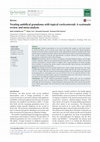
Journal of Research in Clinical Medicine
Background: Umbilical granuloma so far can be treated with surgery or with silver nitrate. In lim... more Background: Umbilical granuloma so far can be treated with surgery or with silver nitrate. In limited facilities such as in remote areas where the surgeon is limited, pharmacological therapy with silver nitrate or topical steroid can be given. However, treatment with silver nitrate requires medical personnel and has unfavorable adverse effects if done by improper technique. This systematic review aimed to evaluate the effectiveness of topical steroid for treating an umbilical granuloma compared to silver nitrate therapy. Method: The literature search was done using search engines including PubMed, Embase, and Google Scholar. Literature selection was performed with limitations from 2000 to 2020 to get the novelty and written in the English language with a target population of infants less than 6 months were included. To retrieve the articles, topical corticosteroids, topical steroids, and umbilical granuloma were used as keywords. Results: The findings from the included studies show ...
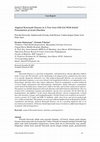
Journal of Medicine and Health, 2021
Kawasaki Disease is a spectrum of idiopathic, self-limited fever disease affecting children under... more Kawasaki Disease is a spectrum of idiopathic, self-limited fever disease affecting children under 5 years old. This disorder can be challenging to be diagnosed by a pediatrician since there is no specific diagnostic laboratory test. One atypical Kawasaki Disease case presented with gastrointestinal symptoms, a two-year-old girl was hospitalized with fever, accompanied by non-hemorrhagic diarrhea three days before admission. Physical examination revealed unilateral cervical lymph enlargement and mild-moderate dehydration. Initial laboratory examination result showed thrombocytosis, leukocytosis (shift to the left), and normal routine fecal analysis. The patient was initially diagnosed with acute diarrhea with mild-moderate dehydration. She was treated with a rehydration regimen and antibiotic, but her fever persisted. On the third day of hospitalization, she fulfilled 3 of the classic Kawasaki Disease criteria (conjunctivitis, cracked lips with strawberry tongue, and lymphadenopathy). Further blood work resulted in increased C-reactive protein 43.35 mg/L and ESR 72 mm/hour, while chest X-ray and electrocardiograph were within normal limit. This patient was proceed to Hasan Sadikin General Hospital for further examination and therapy. Atypical Kawasaki Disease can be a puzzling diagnosis due to its uncommon presentations. Clinicians should importantly keep it in mind as a differential diagnosis in patients with prolonged fever.

Background: Expanded Dengue Syndrome (EDS) is definded as Dengue case with unusual presentation w... more Background: Expanded Dengue Syndrome (EDS) is definded as Dengue case with unusual presentation which falls into neither Dengue Hemmorhagic Fever nor Dengue Shock Syndrome in World Health Organization’s (WHO) criteria. This atypical clinical manifestation with liver, kidney, brain, or heart organs involvement is associated with co-infection, co-morbidities, or complications of prolonged shock; and commonly undiagnosed or underreported.
Objective: To report an EDS case diagnosed with acute dystenriae diarrhea, urinary tract infection (UTI), and hypoalbuminemia.
Case: A 3-year-old girl, KE, was admitted with chief complaint of 4-day fever followed by diarrhea and vomitting 1 day before the admission date. Physical examination showed T:38.4oC and mild-to-moderate dehydration signs. Initial laboratory findings revealed increased hemoconcentration (Ht:45%, Tr:152.000/mm3) and dysentriae (fecal mucous [+], leucocyte [+4-6]), strengthening the initial diagnosis of Dengue Hemorrhagic Fever + acute dystenriae diarrhea with mild-to-moderate dehydration. She was feverish on hospitalization day-5 (T:39.0oC), had abdominal pain, ascites (AC:61cm), and anasarca (alb: 1.5 g/dl). The fever persisted through hospitalization day-12 (peak:39.2oC). On the 9th hospitalization day, we found UTI (Urinary leucocyte: macroscopic:+3, microscopic:+14). After the administration of intraveous fluid, Albumin 20% transfusion, dan antibiotic (Cefotaxime switched to Meropenem) therapy, she showed clinical improvement and was discharged on hospitalization day-14. Blood culture examination was not taken due to financial problem.
Conclusion: Expanded Dengue Syndrome often manifests as Dengue Fever with atypical presentation accompanied by co-infection and multiple organ involvement. Early diagnosis and prompt treatment are keys to prevent increased morbiditity and mortalitity.
Keyword: co-infection, dysentriae, Expanded Dengue Syndrome (EDS), Urinary Tract Infection (UTI).











Uploads
Papers by Permata Putri Karina
Objective: To report an EDS case diagnosed with acute dystenriae diarrhea, urinary tract infection (UTI), and hypoalbuminemia.
Case: A 3-year-old girl, KE, was admitted with chief complaint of 4-day fever followed by diarrhea and vomitting 1 day before the admission date. Physical examination showed T:38.4oC and mild-to-moderate dehydration signs. Initial laboratory findings revealed increased hemoconcentration (Ht:45%, Tr:152.000/mm3) and dysentriae (fecal mucous [+], leucocyte [+4-6]), strengthening the initial diagnosis of Dengue Hemorrhagic Fever + acute dystenriae diarrhea with mild-to-moderate dehydration. She was feverish on hospitalization day-5 (T:39.0oC), had abdominal pain, ascites (AC:61cm), and anasarca (alb: 1.5 g/dl). The fever persisted through hospitalization day-12 (peak:39.2oC). On the 9th hospitalization day, we found UTI (Urinary leucocyte: macroscopic:+3, microscopic:+14). After the administration of intraveous fluid, Albumin 20% transfusion, dan antibiotic (Cefotaxime switched to Meropenem) therapy, she showed clinical improvement and was discharged on hospitalization day-14. Blood culture examination was not taken due to financial problem.
Conclusion: Expanded Dengue Syndrome often manifests as Dengue Fever with atypical presentation accompanied by co-infection and multiple organ involvement. Early diagnosis and prompt treatment are keys to prevent increased morbiditity and mortalitity.
Keyword: co-infection, dysentriae, Expanded Dengue Syndrome (EDS), Urinary Tract Infection (UTI).
Objective: To report an EDS case diagnosed with acute dystenriae diarrhea, urinary tract infection (UTI), and hypoalbuminemia.
Case: A 3-year-old girl, KE, was admitted with chief complaint of 4-day fever followed by diarrhea and vomitting 1 day before the admission date. Physical examination showed T:38.4oC and mild-to-moderate dehydration signs. Initial laboratory findings revealed increased hemoconcentration (Ht:45%, Tr:152.000/mm3) and dysentriae (fecal mucous [+], leucocyte [+4-6]), strengthening the initial diagnosis of Dengue Hemorrhagic Fever + acute dystenriae diarrhea with mild-to-moderate dehydration. She was feverish on hospitalization day-5 (T:39.0oC), had abdominal pain, ascites (AC:61cm), and anasarca (alb: 1.5 g/dl). The fever persisted through hospitalization day-12 (peak:39.2oC). On the 9th hospitalization day, we found UTI (Urinary leucocyte: macroscopic:+3, microscopic:+14). After the administration of intraveous fluid, Albumin 20% transfusion, dan antibiotic (Cefotaxime switched to Meropenem) therapy, she showed clinical improvement and was discharged on hospitalization day-14. Blood culture examination was not taken due to financial problem.
Conclusion: Expanded Dengue Syndrome often manifests as Dengue Fever with atypical presentation accompanied by co-infection and multiple organ involvement. Early diagnosis and prompt treatment are keys to prevent increased morbiditity and mortalitity.
Keyword: co-infection, dysentriae, Expanded Dengue Syndrome (EDS), Urinary Tract Infection (UTI).